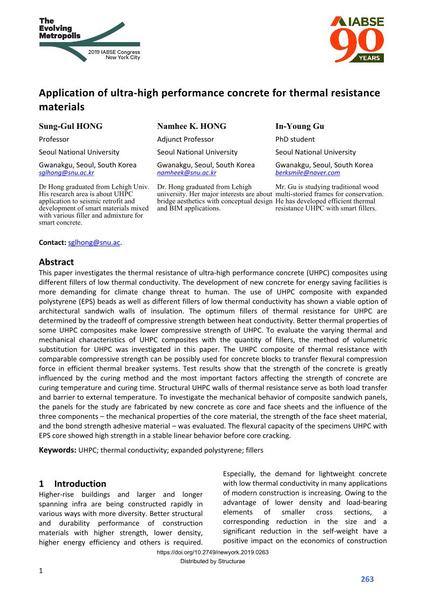Application of ultra-high performance concrete for thermal resistance materials

|
|
|||||||||||
Détails bibliographiques
| Auteur(s): |
Sung-Gul Hong
(Seoul National University)
Namhee K. Hong (Seoul National University) In-Young Gu (Seoul National University) |
||||
|---|---|---|---|---|---|
| Médium: | papier de conférence | ||||
| Langue(s): | anglais | ||||
| Conférence: | IABSE Congress: The Evolving Metropolis, New York, NY, USA, 4-6 September 2019 | ||||
| Publié dans: | The Evolving Metropolis | ||||
|
|||||
| Page(s): | 263-270 | ||||
| Nombre total de pages (du PDF): | 8 | ||||
| DOI: | 10.2749/newyork.2019.0263 | ||||
| Abstrait: |
This paper investigates the thermal resistance of ultra-high performance concrete (UHPC) composites using different fillers of low thermal conductivity. The development of new concrete for energy saving facilities is more demanding for climate change threat to human. The use of UHPC composite with expanded polystyrene (EPS) beads as well as different fillers of low thermal conductivity has shown a viable option of architectural sandwich walls of insulation. The optimum fillers of thermal resistance for UHPC are determined by the tradeoff of compressive strength between heat conductivity. Better thermal properties of some UHPC composites make lower compressive strength of UHPC. To evaluate the varying thermal and mechanical characteristics of UHPC composites with the quantity of fillers, the method of volumetric substitution for UHPC was investigated in this paper. The UHPC composite of thermal resistance with comparable compressive strength can be possibly used for concrete blocks to transfer flexural compression force in efficient thermal breaker systems. Test results show that the strength of the concrete is greatly influenced by the curing method and the most important factors affecting the strength of concrete are curing temperature and curing time. Structural UHPC walls of thermal resistance serve as both load transfer and barrier to external temperature. To investigate the mechanical behavior of composite sandwich panels, the panels for the study are fabricated by new concrete as core and face sheets and the influence of the three components – the mechanical properties of the core material, the strength of the face sheet material, and the bond strength adhesive material – was evaluated. The flexural capacity of the specimens UHPC with EPS core showed high strength in a stable linear behavior before core cracking. |
||||
